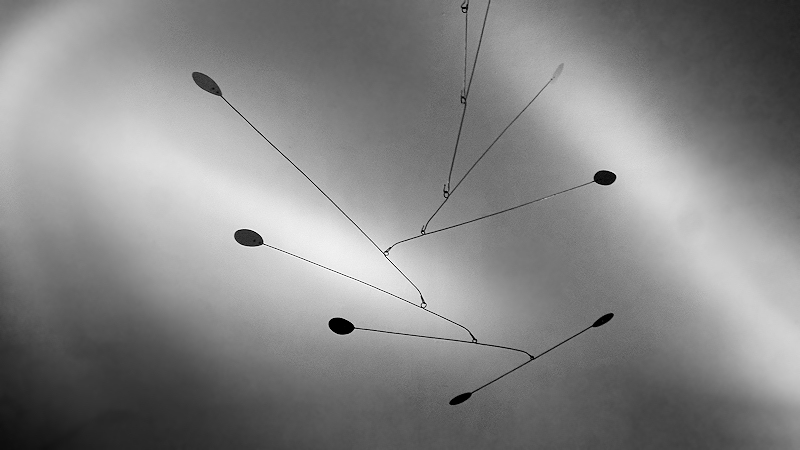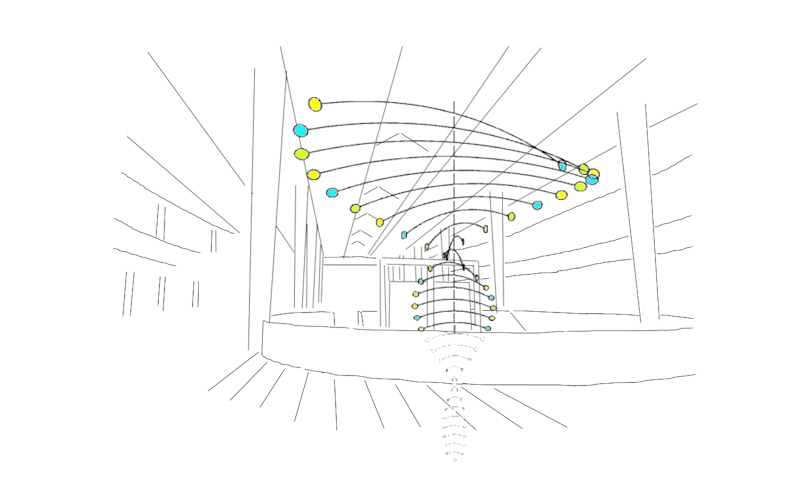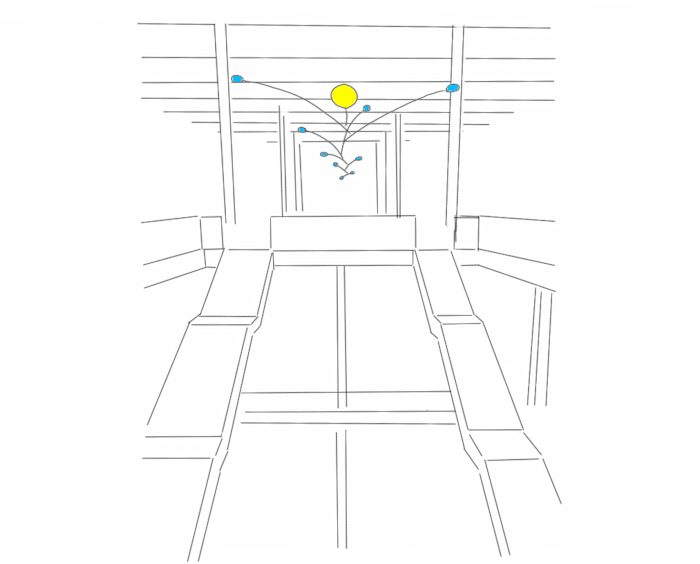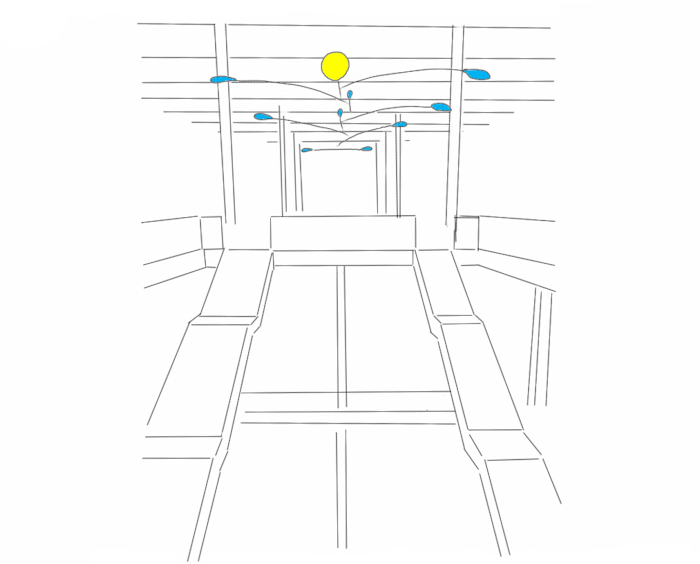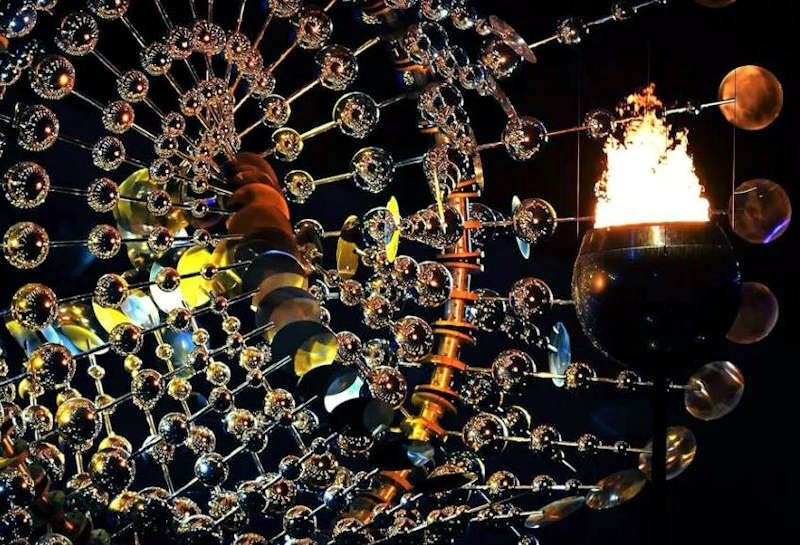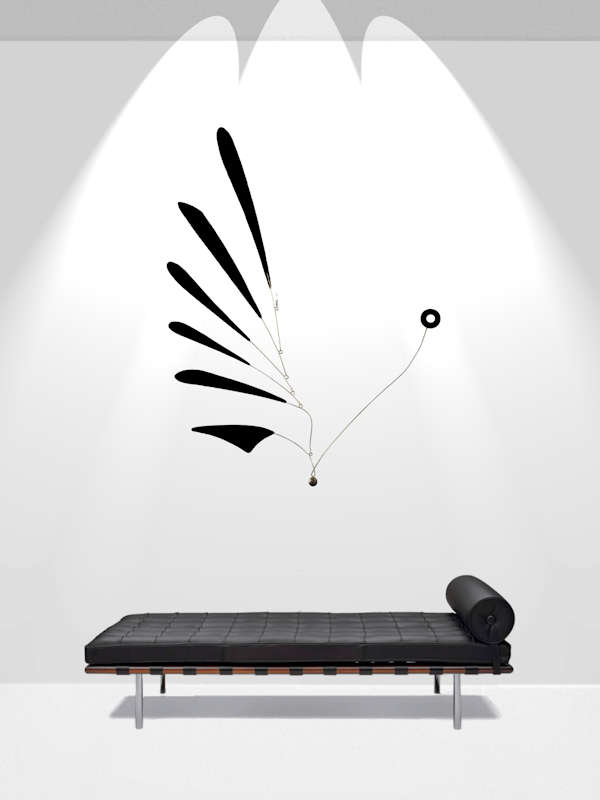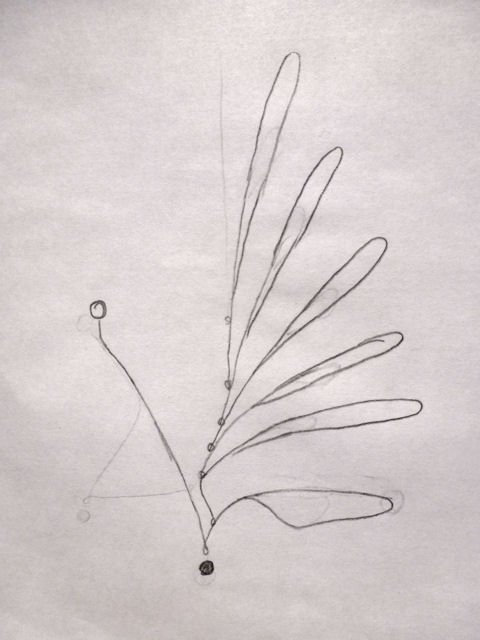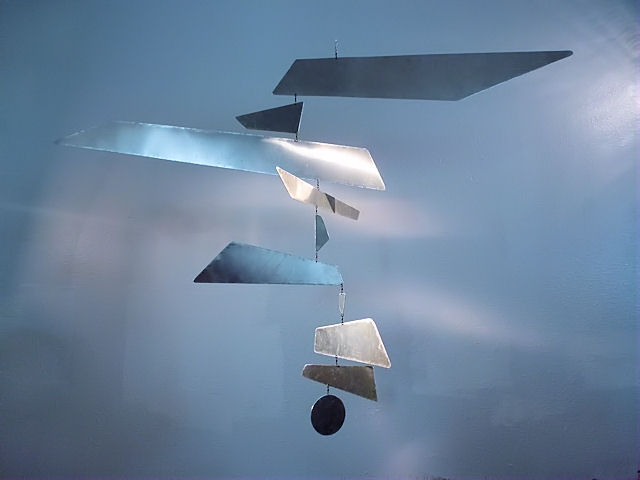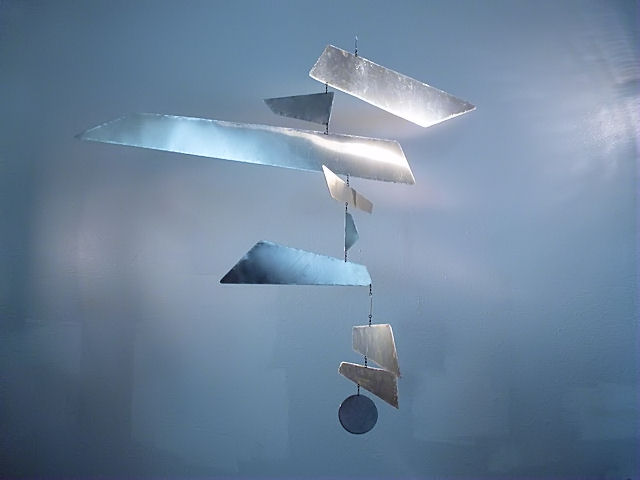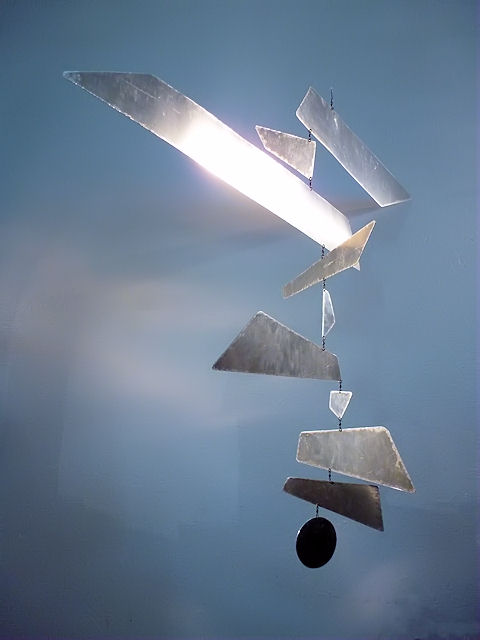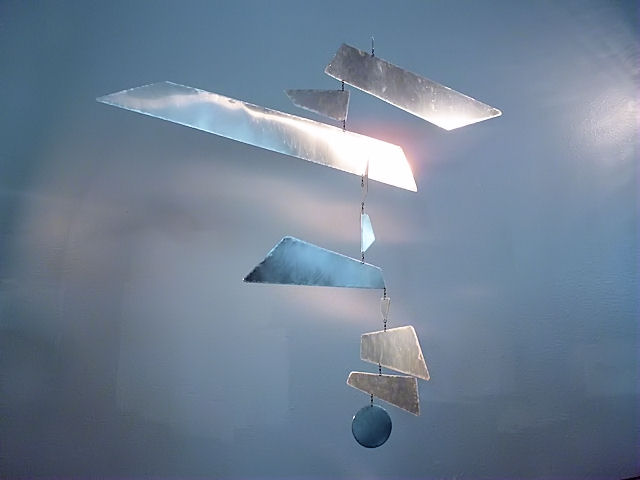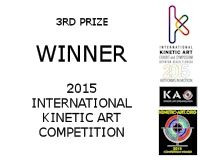Designs for large custom mobiles for a shopping mall – Part 2 – Main Atrium
Custom design of a large scale hanging mobile for the main atrium of a shopping mall in Kazakhstan:
See more of my custom mobiles …
Designs for large custom mobiles for a shopping mall – Part 1 – Smaller Atrium
Designs / sketches of two large custom hanging mobiles for a shopping mall in Kazakhstan:
See more of my custom mobiles …
What is the largest kinetic sculpture / mobile in the world?
There’s an amazing kinetic sculpture titled Kinetic Rain at Changi Airport designed by the highly creative and innovative ART + COM and manufactured and installed by MKT, Olching:
Links to various videos of the installation keep floating around social media sites calling it “the largest kinetic sculpture in the world”, spanning an area of 75 square meters (810 sq ft) and a height of 7.3 meters (24 ft). While the sculpture is an amazing accomplishment, it doesn’t seem to be the world’s largest kinetic sculpture. To my knowledge, the largest kinetic sculpture in the world (and also the largest mobile sculpture) is Alexander Calder‘s White Cascade, which hangs in the Eastburn Court of the Federal Reserve Bank of Philadelphia:
It measures approximately 100 feet (31 meters) from top to bottom, is 60 feet (18 meters) at its widest point, and weighs close to 10 tons, including the motor, surpassing Calder’s 920 pound 76-foot-long mobile (or 85 feet, depending on source) at the National Gallery of Art in Washington, DC. I’m not sure if any of his stabiles are larger, but if not, then this would also be Alexander Calder’s largest sculpture. Speaking of that large Calder mobile at the National Gallery, it is made with hollow honeycomb-type structures designed by Paul Matisse (grandson of Henri Matisse and son of Pierre Matisse) and covered with paper-thin aluminum, and aluminum and steel bars, with the stress points being strengthened with molybdenum. It weighs 930 pounds (422 kg). The previous estimates from Calder’s foundry in Biémont exceeded 5000 pounds (2268 kg). It doesn’t have a name. When Calder was asked for a title, he replied “You don’t name a baby until it is born.” But then he passed away one year before it was installed at the Gallery. The mobile sculpture has been refurbished recently.
Back to White Cascade: It took just two days to install it. The installation was carried out in two stages. In the most difficult and time-consuming part of the job, the four top-most and largest aluminum discs — still in their protective wrappings — were joined to their respective stainless steel rods, then raised one by one and linked together. The 10 lower discs and rods were linked together on the ground level, then raised into position as a unit. A crane situated on the sidewalk outside the entrance to the Bank provided the lifting power.
Finally, the wrappings were removed. The 14 white aluminum discs that comprise “White Cascade” range in size from 3.5 feet in diameter to 12.7 feet. The longest of the connecting stainless steel rods is 36 feet; the shortest, 9 feet. Powered by an electric motor, the mobile rotates clockwise on a radius of 32.5 feet.
Here’s a photo by H. Scott Heist of Calder in front of the mobile:
The mobile was installed in May 1976, Calder passed away less than six months later.
Do you know of a larger kinetic sculpture? Let me know if you do and I’ll add it to this post.
Also see my list of the 5 Largest Mobiles worldwide that I’m aware of.
– Update: –
I received an email from Anthony Howe nominating his OCTO 3 sculpture as possibly the largest outdoor permanent kinetic wind sculpture. It measures 25′ h x 30′ w x 30′ d (7.6m x 9.1m x 9.1m) and weighs 7000 pounds (3200 kg):
Since receiving the email from Anthony, it seems that he has surpassed these dimensions with the cauldron he created for the 2016 Rio Olympics measuring 40 ft (12.2 meters):
Related: Watch as Anthony Howe creates a massive, kinetic wind sculpture
– See some of my kinetic sculptures and mobiles –
Iconic 1960 Calder mobile from private collection on offer
Alexander Calder, Maripose, 1960, 30 x 67in.
Bonhams will offer Alexander Calder‘s (1898-1976) 1960 sculpture Maripose in the November 12 2013 Contemporary Art auction (est. $1,200,000-1,600,000). This stunning example of Calder’s large scale mobiles has been in private American hands for nearly 40 years in Wisconsin-based collections.
A native of Pennsylvania, Calder was born into a family of sculptors. His first solo show was held in Paris in 1927 while he was still in his twenties; he would soon become one of America’s most lauded and prolific artists. It was Marcel Duchamp who first dubbed Calder’s kinetic wire sculptures “mobiles,” – these hanging, interactive pieces would come to define the artist’s legacy.
Maripose was originally offered at Perls Gallery in New York, which represented Calder from 1954 until the artist’s death. The mobile was acquired in 1976 by a prominent private collector from Milwaukee’s Irving Galleries, and passed by descent to the present owner in 1988. The mobile was exhibited at the Milwaukee Art Museum in 1987, and is registered with the Calder Foundation.
“In Maripose, every element of Calder’s genius is evident through the striking sense of balance and momentum the sculpture evokes,” said Jeremy Goldsmith, Bonhams Director of Contemporary Art in New York. “It’s a pleasure to bring such an important work to the market after nearly four decades in private hands.”
The auction will preview at Bonhams November 9-12 2013.
Custom Hanging Mobile Sculpture and Mies van der Rohe Daybed
A custom designed mobile I made in 2012 with the modern classic Mies van der Rohe daybed (to illustrate the size of the mobile). It measures 5.5 feet in height and 4.5 feet width, made with steel (sheet metal, wire, rivets) and a solid lead metal weight:
This mobile became the original inspiration for the custom-made mobile I made for the movie The Upside released in 2019.
It seems to me that this mobile crosses over from a mid-century modern style to a more contemporary one, in one of my earlier ventures to break away from Alexander Calder‘s work and to expand the art form of mobiles that he created beyond his work, which eventually led to these contemporary mobile sculptures, this hypothesis and these much more complex and intricate mobile sculptures.
The mobile shown here moves beautifully with the air currents. Although originally not intended for outdoors, I suspended it in the yard for a while, and it proved strong enough to withstand an intense storm. The weight at the bottom provides for quite a bit of stability. It’s a kinetic mobile sculpture, but it would make for a sophisticated hanging wall sculpture as well. I still have a stack of drawings with mobiles similar to this one, based on the same idea or theme (bird like?). I may get around to turning those drawings into mobiles eventually.
It seems that Stephen H. Kawai may have felt inspired by this mobile with his Ghost Bird (2018).
– See more of my mobile sculptures –
New large hanging mobile – Mobile 92
Just finished making a 6 foot (2 meter) sheet metal version of this hanging mobile design (a bird?):
It looks amazing! And moves amazingly well too with the wind currents. I can’t wait to post photos of it, maybe a video, too. Not sure yet what would be the best place / background for pictures. A plain white simple space? A farm? Maybe a lake.
[Update: Image with Mies van der Rohe daybed]
Calder’s “Hello Allentown”, hanging mobile, for sale
[Update: Christie’s will have four Calder mobiles for sale on May 15th 2013]
Christie’s Post War and Contemporary Art Evening Auction on October 11th 2012 in London will include Alexander Calder‘s “Hello Allentown“, a hanging mobile he made the same year he passed away, 1976.
Expected to go for US$ 2 to 3 Million. More affordable options are here and here.
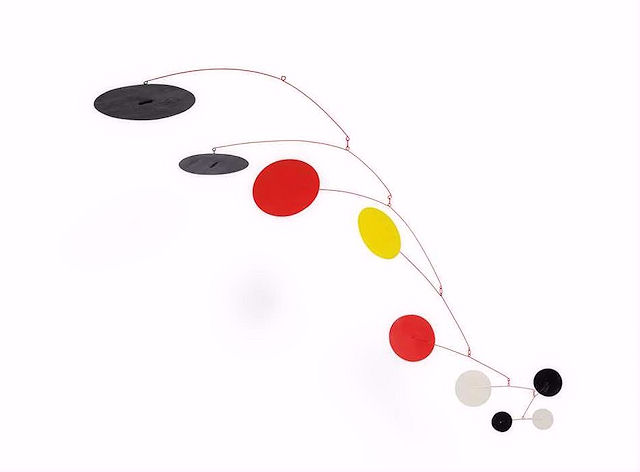
Before moving on to the Lot Notes, does anyone know if this quote is really by Calder: “The perpetually changing relations within the mobile gives them a metaphysical identity that relies on temporal memory to assemble the sequence of partial definitions comprising the more complex identity of the whole.”
Lot Notes: ‘The simplest forms in the universe are the sphere and the circle, I represent them by discs and then I vary them. My whole theory about art is the disparity that exists between form, masses and movement’ (A. Calder, quoted in K. Kuh, The Artist’s Voice: Talks with Seventeen Artists, New York, 1962).
Suspended from a sequence of bright red wires, the progression of multi-coloured discs that glides through the air is a triumphal example of Alexander Calder’s iconic mobile sculptures. Having once formed part of the historic collection of Philip and Muriel Berman and in fact titled after their hometown, Allentown, Pennsylvania, Hello Allentown is a tribute to the lifelong journey of collecting during which they amassed an impressive collection of monumental and important sculpture, paintings, drawings and prints. True civic leaders well known for their philanthropy as well as their commitment to championing the work of both young aspiring artists and the masters of their time, Philip and Muriel Berman collection was a testament to their personal connection with the art and in many instances their personal friendships with the artists, a friendship evident through the very title of Hello Allentown. With the artist signature aplomb, the vibrant spheres occupy both the vertical and horizontal planes, commanding the space in which they hang. The black discs that mark the highest and lowest point of Calder constellation act to contain the energetic eruptions of fiery reds and iridescent yellow that are contained within the centre of the configuration. Hello Allentown incorporates two of Calder favourite monikers – his exuberant use of colour and his formal examination of the spherical form. Through these two devices Calder investigates the formal relationship between two of the most basics tenets of art – form and colour – and how they interact, particularly in three-dimensional form. From the large black disc at the apex of the composition the eye is drawn down through a series of graceful arching limbs, each of which supports a round disc which decreases in size as the sculpture draws to a triumphal conclusion, ‘The simplest forms in the universe are the sphere and the circle Calder once said, ‘I represent them by discs and then I vary them. My whole theory about art is the disparity that exists between form, masses and movement’ (A. Calder, quoted in K. Kuh, The Artist’s Voice: Talks with Seventeen Artists, New York, 1962).
In addition to its elegantly balanced form, Hello Allentown is also distinguished by its chromatic range and intensity. Colour was an important expressive device for the artist and one of the most important factors in his compositions. For Calder, colour was not a representational force but rather an emotional one, in much the same way as Henri Matisse and André Derain, the historical pioneers in non-traditional use of colour. As Calder himself once commented: ”I want things to be differentiated. Black and white are first – then red is next. I often wish that I had been a Fauve in 1905” (A. Calder, quoted in Calder, London 2004, p. 89). Hello Allentown clearly demonstrates this philosophy with its harmonious use of black and white discs to compliment the chromatic brilliance of its red and yellow core.
Whilst Calder”s influential visit to Mondrian”s Parisian studio in 1930 is well documented as being the spark that ignited his interest in introducing colour and movement into sculpture, it is perhaps his friendship with Joan Miró that had the greatest influence on his career. The two men first met in 1928 and remained lifelong friends until Calder death in 1976. ”We became very good friends,” Calder once said, ”and attended may things together I came to love his painting, his colour, his personages” (A. Calder, quoted in E. Hutton and O. Wick (eds.), Calder, Miró, London 2004, p. 27). Their friendship was based on outsiders from the established art scene and reveled in their disdain of convention. From the early stages of their relationship, the pair explored the increasingly dominant field of abstraction – Calder prompted by his visit to Piet Mondrian”s atelier and Miró with his painterly forms that would eventually morph themselves into his iconic Constellations a few years later. The various coloured discs of Hello Allentown recall the lyrical, semi-abstracted forms of Miró paintings, a visual relationship that is emphasised by the fact that they held together by wires which resonate with the elegant sense of calligraphic line of the Spanish artist.
The present work is a rare example of a mobile that was produced during the latter part of Calder”s career. From the mid-1950s onwards Calder became increasingly concerned with making large-scale outdoor sculptures, making over three hundred monumental works that were placed in city plazas, corporate lobbies, airports and museum during the post-war building boom. It was through an incredible act of generosity and through their friendship with Calder that Philip and Muriel Berman, the renown first owners of Hello Allentown, provided the financing for Homage to Jerusalem-Stabile (1977), a work that would prove to be the last monumental sculpture planned by Calder but which he would not live to see installed on the site he chose on Jerusalem”s Holland Square. That Calder would return to his beloved mobiles during the final year of his life is testament to the importance in which he held this forms. As such, Hello Allentown represents the pinnacle of Calder”s approach to the prevailing march towards abstraction. Calder wanted to redefine the nature of art, and of sculpture in particular, by taking it off the wall and the pedestal and breathing movement into its static form. The resulting mobiles were his revolutionary response to these ideas of movement and colour and Hello Allentown is the superb result of Calder”s unfettered imagination and his unmatched technical skill as an engineer that enabled him to produce works that spring into life with the slightest breath of wind.

